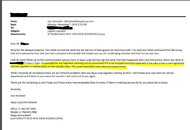Since
@databob has resurrected this thread, as a learning piece for all, I thought I'd summarise everything.
I do have a personal vested interest in any problems with the Legend ACD 1st stage, since I own 3 sets. All of them are regularly used (more than once a month) on dives beyond those considered recreational. Mine only differ from standard in that they have all been rebuilt as 100% O2 compatible
The OP originally had an OOA at 60' some 40 mins into the dive with 1500 psi still left in his tank. The Reg had been serviced some 25 dives before. He took the Reg to a different AL service centre who diagnosed that the Yoke nut and ACD shutter valve were loose and that was the problem. There has been some debate on this and a similar incident as to whether this was the correct diagnosis
In order to understand the issues, I've attached diagrams and pictures below.
AL in May 17 issued a technical bulletin recalling some regs because of a loose ACD
View attachment 482862
In Picture B you can see the gap in between what's called the shutter crown and the Nut. The Torque settings had been revised to help prevent this. The ACD beign loose isn't' as big an issue as one might think. (I'll come to that)
The Picture below identifies the major components so people can understand the terminology
View attachment 482863
Below is a cut through drawing
View attachment 482864
The Purple part in the centre is the shutter valve. It does not move. It's the Shutter crown which surrounds it, that is pushed back as you tighten the yoke or Din allowing air to pass through. The Shutter valve just screw in however retaining the whole assembly
Note the lower O ring. If the Shutter valve unscrews then this O ring will fail to seal allowing gas to come around the outside of the Shutter Crown. The user hears a gas leak as if there were no O ring. On Din Models, its not uncommon if the user removes the 1st with a bit of pressure remaining for the crown to turn loosening the shutter valve - the next time you put it on a tank you have a leak. Simple fix, tighten it with a hex keY
It does not need much to get this leak. If the Shutter valve unscrews 1 quarter of a turn you'll get a leak. This is the fail safe. If teh Shutter valve is not fully installed it give you a major leak when you pressurise the cylinder. The same can happen on Yoke if you over tighten and then twist the yoke to loosen the 1st stage
I know this because it's happen to me more than once when I've been careless (rushing) changing tanks I carry a Hex key to nip it back up. No problem.
This is why I reject the theory of the Loose ACD
What about the yoke nut?
View attachment 482865
This is a pic of my DIN ACD (which looks really grotty at this magnification - it's due a service in Dec after 200+ dives over 18 months)
The thing to notice here is the Gap between the end of my DIN threads and the back of the shutter valve. It's approx 1mm / 0.040" with the ACD obviously closed.
The Max movement of the ACD is this 1mm/0.040" That's all it need to move to fully open the airway.
Now look again at the first photo. There is a great deal of the shutter crown protruding past the yoke nut, at least 5mm/0.200"
Even if the O- ring is slightly recessed as long as around 2mm/0.080" of the shutter crown is exposed it will be enough to push back fully. If the Yoke nut was that loose, the User would have surely notice how loose the A clamp was.
So I also reject a loose yoke nut as the cause and even a combination of both.
Why did a Dive shop identify the loose ACD and yoke as the cause? It's not uncommon for people to see a fault and immediately label that as the problem. In this case I'm certain they were wrong.
I've also double check this with a very very well respected AL Service Eng who concurred with the above
So what was the cause?
Without the offending 1st stage it's impossible to say.
I presume and Correct me if I'm wrong being on a liveaboard the tank used on that dive had been used before and after the incident - generally in my experience they stay connected to your kit - ? We know they apparently checked the valve underwater. Otherwise the cylinder valve or debris tube inside could have been suspect/ partial blockage.
The OP might not have tighten the yoke properly thus not opening the ACD - although unlikely as you shoudl get a leak from a bad seal? Or the OP might have had a really loose yoke nut - but I'm discounting that because I'm sure the OP would have notice or their buddy would have seen bubbles
Because the reg had been used - a build service issue isn't obvious unless it took a few dives for the defect to appear
Or it could be a blocked/ partially blocked filter (in proper service).
So in summary, we'll never know the true cause. but it's safe to say the suggested cause was false. The ACD is designed to fail safe, in that if it comes loose you just don't' get any air at all on the surface, just a big leak
Whether you like the ACD or not (I do and I also have regs without ACD so I'm aware of the differences) is immaterial
The failure modes put forward initially by the dive shop just don't cut it.
I'm certainly happy to continue to use ACD I think others should be too
Safe diving





